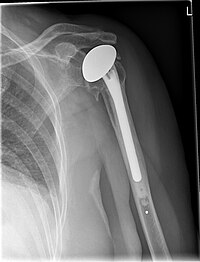
Photo from wikipedia
IntroductionSecondary cuff failure after shoulder replacement is disabling and often requires additional surgery. Increased critical shoulder angle (CSA) has been found in patients with cuff tear compared to normal subjects.… Click to show full abstract
IntroductionSecondary cuff failure after shoulder replacement is disabling and often requires additional surgery. Increased critical shoulder angle (CSA) has been found in patients with cuff tear compared to normal subjects. The interobserver reliability of the CSA and the relationship between CSA and symptomatic secondary cuff failure after shoulder replacement were investigated.Materials and methodsNineteen patients with symptomatic cuff failure after anatomic shoulder replacement (mean FU 45 months) were compared to a control group of 29 patients showing no signs of symptomatic cuff failure (mean FU 105.7 months). The CSA was measured by two blinded surgeons at a mean follow-up of 45 and 105.7 months, respectively. Inter-observer reliability was calculated.ResultsThe mean CSA in the study group in neutral, internal and external rotations were 33°, 34° and 34°, respectively. Corresponding values in the control group were 32°, 32° and 32°. The interclass correlation coefficient for the whole population between the two examiners were 0.956 (P < 0.01), 0.964 (P < 0.01) and 0.955 (P < 0.01), respectively.ConclusionThere were no significant differences of CSA values between patients who had undergone shoulder replacement and experienced late cuff failure and those in whom the same procedure had been successful. A good inter-observer reliability was found for the CSA method.
Journal Title: Archives of Orthopaedic and Trauma Surgery
Year Published: 2017
Link to full text (if available)
Share on Social Media: Sign Up to like & get
recommendations!